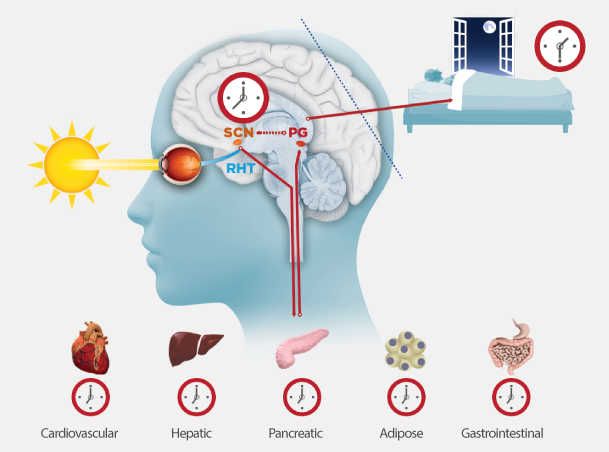Light Is Essential to Synchronize the Master Body Clock
Circadian rhythms are the expression of the intricately balanced endogenous timing system that governs most physiologic processes. Approximately 20,000 neurons located in regions of the hypothalamus called the suprachiasmatic nuclei (SCN) comprise the circadian rhythm regulatory center, or master body clock (See Figure).1
On average, the master body clock in humans runs slightly longer than 24 hours each day. In sighted people, photic input is captured by intrinsically photosensitive retinal ganglion cells located in the ganglion cell layer of the retina and transmitted to the master body clock.2,3 The master body clock then triggers autonomic and neuroendocrine signals throughout the body to synchronize peripheral clocks and their corresponding rhythms in all other tissues, including but not limited to the heart, lungs, liver, pancreas, and gastrointestinal tract.4
In the majority of people who are totally blind, the master body clock is unable to reset due to the lack of light perception. Continual delays of the body clock relative to the 24-hour day results in prolonged periods of misalignment between their circadian rhythms and the 24-hour day-night cycle.5,6

Alignment of Circadian Rhythms to the 24-Hour Light-Dark Cycle. As daylight appears each morning, light stimulates intrinsically photosensitive retinal ganglion cells (ipRGCs) to transmit signals to the master body clock in the suprachiasmatic nucleus (SCN) via the retinohypothalamic tract (RHT).
The SCN uses neuroendocrine and autonomic signals to synchronize rhythms in all other tissues—including, but not limited to cardiovascular, hepatic, pancreatic, adipose, and gastrointestinal—to itself. As light decreases at the end of the day, melatonin is secreted by the pineal gland (PG), the alerting signal is quieted, and sleep ensues.
Non-24: A pattern of disruption
A circadian cycle is defined as the number of days between two consecutive alignments of the master body clock to the 24-hour day. In individuals with a synchronized master body clock, the circadian cycle length is equal to one day. But for patients with Non-24, the length of the cycle can vary from around a month to nearly a year in length. Patients with very long cycles may not recognize they have a cyclical pattern.6,7
For patients with Non-24, the master body clock becomes misaligned, resulting in a shift in the timing of melatonin and cortisol secretion that affects their sleep-wake patterns.8 Additionally, people with Non-24 often experience symptoms in other physiologic systems governed by the circadian system such as cognitive function, mood, and metabolism.8,9
Ultimately, people with Non-24 often find it hard to go to sleep when they want to, are unable to sleep through the night, don’t awaken refreshed, take frequent naps during the day, and may have difficulty concentrating–all of which may have an effect on their mood.8,10,11
Learn how the symptoms of Non-24 affect patients. Review the impact Non-24 can have in the patients’ own words.



You are opting to leave this site
By following this link, you are leaving www.Non-24Pro.com. These site(s) to which you are linking are not controlled by Vanda Pharmaceuticals, Inc. Vanda Pharmaceuticals, Inc. is not responsible for their content or your use of them.
Are you sure you want to leave? Click Leave Site to continue or Go Back to stay.






